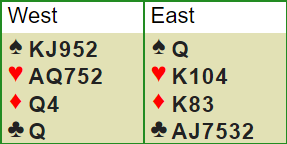AuthorThis series will present the foundation and further developments of the most popular system of natural bidding, called "2/1 Game Forcing", or "2/1" as a shorthand. We will explore the reasoning behind the system, and discuss situations in which there is more than one obviously superior approach. In fact, there will be 3 categories of agreements that will be presented here:
This series has no end in sight. I don't know how many articles will be written. If there is enough interest, we can even get into more space-age approaches (such as 2 Clubs artificial over 1 Major opening, and Gazzilli). But for now we will begin at the beginning, from the ground up. Why play 2/1?2/1, as the most popular natural style, replaced what is nowadays called "Goren" (after the player who most popularized that style), or "Standard American". Online, it is easy to find people claiming to play SAYC, which stands for "Standard American Yellow Card". If you have learned bridge before, say, the 2000's, the odds are that you have learned to bid in that style, and was only later presented to 2/1. The replacement is understandable. 2/1 produces better results. And it is even easier to play! It is not a panacea; we will see some soft spots in the system. But it is superior to SAYC, and it is important to understand why. 2/1 better conforms to a bidding principle, which is, determine as early as possible if the combined strength of the hands are enough to produce game. The idea behind that principle is that the main goal of any bidding system (in the unimpeded auction... contested auctions are a different animal, which will be discussed later) is to reach as many makeable games as possible. Incidentally, this is why we focus on looking for a major suit -- because game is easier to make there than in a minor. If all suits had the same worth, bidding systems would suffer an enormous overhaul. SAYC would respond with a 2/1 (e.g. 2 Clubs over a 1 Heart opening) with hands in the 10+ range, i.e., in the invitational-plus category. It makes for a better description of invitational hands (which often have to respond with a forcing NT in the 2/1 system). But it also means that the partnership is still unaware of whether the hands should bid game. Then, if opener made a minimum but forcing rebid (a new suit, traditionally), the partnership was still in the dark. And then someone had to jump in order to announce game-forcing strength. This wasted space and was prone to accidents. 2/1 is simpler. If you bid at the 2-level over a 1-Major opening, you are indicating game forcing values. (There is a popular style that includes one exception -- invitational one-suited hands. We'll discuss it in a later article. For now, let us assume GF values). This means that nobody needs to jump. And so the partnership has plenty of space to focus on the next two goals of bidding (once GF strength is established), answering the following questions:
Let us look at a typical hand to check the superiority of 2/1 over the SAYC: 14 high card points opposite 13. Everyone would like to be in game with these cards. But the best game (4 Hearts) requires careful exploration. In a Standard American context, the auction would begin (with West being dealer) with 1 Spade - 2 Clubs - 2 Hearts. Now, East would like to indicate a stopper in diamonds, while also leaving open the door for further exploration. He is not sure of the best contract. There is one snag, though: 2NT would not be forcing! It would typically show a hand with something like 11 points and 1=3=4=5 distribution. It might also be 2=3=4=4. It would be the last way to warn opener that the hand might not make a game.
So, East would have a real problem here. And it would probably be solved by a 3NT bid. (3 Clubs would also not be forcing). East might try a piece of delicate bidding by essaying 3 Diamonds, and it would work well in this situation, but this would make it quite hard for him to show a 5-6 in the minors, in another hand. Any way you slice it, it is worse for the partnership if East has to bid a non-suit or jump to game, crowding the bidding. How much simpler is their auction in a 2/1 context. East bids a comfortable 2NT, since the auction is already forced to game, and the whole 3-level is available for exploration. West rebids his hearts, showing 5 cards there, and East, with 3-card support and only one diamond stopper, has an easy 4 Hearts bid. This was a choice of games hand, but it is easy to see that the pursuit of slam will also be hindered if players have to jump, or bid non-suits, in order to announce the strength to force to game. By giving priority to that bidding principle -- the partnership must know, as early as possible, whether they are looking for only a part-score or whether they have the strength to try game -- 2/1 has reached its current popularity. In the next article, we will take a look at opener's rebids in the 2/1 context.
1 Comment
Nancy Martin
6/24/2023 07:07:13 pm
Where are the other articles hinted at in this post?
Reply
Leave a Reply. |
Archives
September 2021
Categories
All
|

 RSS Feed
RSS Feed